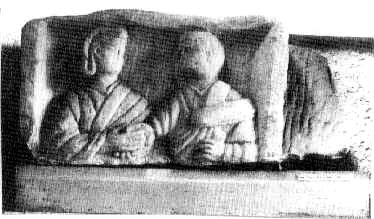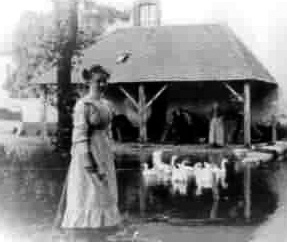The History of Karlsmuehle
Remnants of a Roman stone mill in Mertesdorf. The Karlsmühle holds a special position among the mills in Germany. It is the only mill with a milling tradition which can be traced back to the times of the Romans. In the year 371 AD the Roman writer Ausonius who was working at the Imperial Court in the Roman city of Trier as an educator of Gratian, the young son of the emperor, composed the prized poem "Mosella": In this poem, he also writes about the Ruwer: "In nauseating swirls, the river Ruwer makes the corn-grinding stones rotate, pulling the creaking saws through smooth marble stone blocks." So there must have been not only corn mills but also stone mills in the Ruwer valley at the times of the Romans.
 It is known that slabs of marble and diabas were used in the magnificent buildings of the Roman Trier, and also, in large amounts, slabs sawn out of shell limestone. The marble was imported in large blocks from the South and trimmed for the local construction requirements as close as possible to the town. Diabas, called greenstone by the people in colloquial language, was found in the Grüneberg, a hill limiting the lower Ruwer valley to the West. This is probably also the reason why the stone bears this name. Up to now, the only remnants of buildings found in the Ruwer valley with a hint to a Roman mill have been found near the Karlsmühle. In the middle of the last century, archeologists from Trier found strikingly large blocks of shell limestone in the drainage channel of the Karlsmühle – a stone material which is absolutely non-local in the Ruwer valley. Besides, even today there are still two Roman foundation walls left running towards this mill ditch, now about 20 meters away from the present mill. In the course of channel construction work through the meadows of the river Ruwer in 1967, a large amount of Roman roof and wall tiles was found, and a part of a Roman stone floor was excavated. The most interesting find here was made in 1843, when the remnants of a Roman tomb were discovered at the junction of the drainage channel with the river Ruwer. There, a relief can be seen, showing a bust portrait of a man and woman reaching out to each other, holding hands. To the top, this relief had been limited by a cover stone, with a stone carving showing a mill stone with an axle. Today, this is kept in the State Museum in Trier. This place next to the Ruwer where the Karlsmühle is situated today has apparently been a mill site without interruption since the times of the Romans. So the Karlmühle's milling tradition dates back around 1600 years.
It is known that slabs of marble and diabas were used in the magnificent buildings of the Roman Trier, and also, in large amounts, slabs sawn out of shell limestone. The marble was imported in large blocks from the South and trimmed for the local construction requirements as close as possible to the town. Diabas, called greenstone by the people in colloquial language, was found in the Grüneberg, a hill limiting the lower Ruwer valley to the West. This is probably also the reason why the stone bears this name. Up to now, the only remnants of buildings found in the Ruwer valley with a hint to a Roman mill have been found near the Karlsmühle. In the middle of the last century, archeologists from Trier found strikingly large blocks of shell limestone in the drainage channel of the Karlsmühle – a stone material which is absolutely non-local in the Ruwer valley. Besides, even today there are still two Roman foundation walls left running towards this mill ditch, now about 20 meters away from the present mill. In the course of channel construction work through the meadows of the river Ruwer in 1967, a large amount of Roman roof and wall tiles was found, and a part of a Roman stone floor was excavated. The most interesting find here was made in 1843, when the remnants of a Roman tomb were discovered at the junction of the drainage channel with the river Ruwer. There, a relief can be seen, showing a bust portrait of a man and woman reaching out to each other, holding hands. To the top, this relief had been limited by a cover stone, with a stone carving showing a mill stone with an axle. Today, this is kept in the State Museum in Trier. This place next to the Ruwer where the Karlsmühle is situated today has apparently been a mill site without interruption since the times of the Romans. So the Karlmühle's milling tradition dates back around 1600 years.
In 1325, the mill was passed on from private property to the Himmerod monastery as a donation. For economic reasons, Himmerod sold the mill in 457 to the St. Maximin monastery in Trier. The monastery leased the mill to various tenants until the end of the 18th century. In 1789, Johann Karls married the daughter of a tenant called Schipper. Hence the name Schippersmühle). He acquired the mill in 1803 in the course of the dissolution of the St. Maximin monastery.  Under the name of "Karlsmühle" it has been family-owned ever since until today. In 1889, Johann Geiben from Kirsch married Katharina Karls and thus into the miller's family. In 1893, Peter Geiben was born. In 1921, Peter married Anna Stüeken, a daughter of Franz Stüeken from Gramsau near Balve in the Sauerland. Until that date, Anna Geiben (1897 - 1990) had managed the rock mill from Ruwer, which had been bought by her father at the end of the First World War. When the mill was shut down in 1955, an old milling tradition of more than 1600 years came to an end. In 1964, Peter Geiben died and in 1978, Franz Geiben, too. In 1979, the building was extended whilst conserving the outer facade which dates back to the 18th century – today, a part of our hotel -. Since 1996, Peter Geiben has been the sole proprietor of the Karlsmühle.
Under the name of "Karlsmühle" it has been family-owned ever since until today. In 1889, Johann Geiben from Kirsch married Katharina Karls and thus into the miller's family. In 1893, Peter Geiben was born. In 1921, Peter married Anna Stüeken, a daughter of Franz Stüeken from Gramsau near Balve in the Sauerland. Until that date, Anna Geiben (1897 - 1990) had managed the rock mill from Ruwer, which had been bought by her father at the end of the First World War. When the mill was shut down in 1955, an old milling tradition of more than 1600 years came to an end. In 1964, Peter Geiben died and in 1978, Franz Geiben, too. In 1979, the building was extended whilst conserving the outer facade which dates back to the 18th century – today, a part of our hotel -. Since 1996, Peter Geiben has been the sole proprietor of the Karlsmühle.

